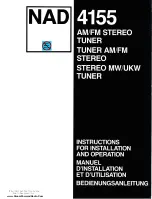
Receiver Mode
R&S
®
ESR
169
User Manual 1175.7068.02 ─ 12
Sample detector
The sample detector displays the instantaneous value of the level at a pixel. It routes
through the sampled data without any further evaluation.
The sample detector is used for IF analysis and for noise or phase noise marker calcu-
lation in analyzer mode. However, it is unreliable if the displayed span is much wider
than the resolution bandwidth or if the tuning steps of the local oscillator are too large.
Quasipeak detector
The quasipeak detector yields the maximum detected value weighted to CISPR
16-1-1
that was detected during the measurement time.
Depending on the set frequency, the R&S
ESR automatically selects the detectors and
IF bandwidths defined for bands A, B and C/D listed in the following table:
Band A
Band B
Band C/D
Frequency range
<
150
kHz
150
kHz to 30
MHz
>
30
MHz
Resolution bandwidth
200 Hz
9 kHz
120 kHz
Charge time constant
45 ms
1 ms
1 ms
Discharge time constant
500 ms
160 ms
550 ms
Time constant of the
mechanical device
160 ms
160 ms
100 ms
The coupling of the resolution bandwidth to the frequency range with activated quasi-
peak detector can be cancelled using the "CISPR RBW uncoupled" softkey.
Regarding measurement time, the relatively long time constants used with quasipeak
detectors entail long measurement times to obtain correct results.
●
With unknown signals the measurement time should be at least 1 s. This ensures
correct weighting of pulses down to a pulse frequency of 5 Hz.
●
With known signals much shorter measurement times can be used.
After internal switching, the R&S
ESRwaits until the measurement result has stabi-
lized before it starts the actual measurement. Since the level does not change dur-
ing a frequency scan, known signals (e.g. broadband RFI) can be correctly mea-
sured with a much shorter measurement time.
CISPR Average detector
The CISPR Average detector yields a weighted average signal level according to
CISPR 16-1-1. The average value according to CISPR 16-1-1 is the maximum value of
the linear average during the set measurement time.
The detector is used, for example, to measure pulsed sinusoidal signals with a low
pulse frequency. It is calibrated with the rms value of an unmodulated sinusoidal signal.
Averaging is with lowpass filters of the 2nd order (simulation of a mechanical instru-
ment).
The lowpass time constants and the IF bandwidths are fixed depending on the fre-
quency. The main parameters are listed in the following table:
Measurement Basics
















































